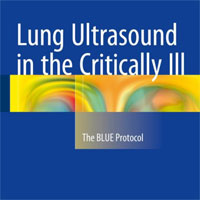Tag: ARF
Hemolysis in Septic Patients with Acute Respiratory Failure: Prognostic Implications
This study highlights the critical role of hemolysis in sepsis and acute respiratory failure, showing a strong association with organ dysfunction. Hemolysis is notably frequent, especially in patients with septic shock... read more
Lung Ultrasound in the Critically Ill: The BLUE Protocol
Written by a pioneer in critical care ultrasound, this book discusses the basic technique and "signatures" of lung ultrasound and explains its main clinical applications. The tools and clinical uses of the BLUE protocol,... read more

Analgosedation Practice During Noninvasive Respiratory Supports
Sedation is frequently used in patients with acute respiratory failure (ARF) undergoing Noninvasive Respiratory Supports (NRSs). Current analgesic practices are becoming more standardized, with analgosedation strategies increasingly... read more
Association Between Ketamine Use and Mortality in Critically Ill Patients Receiving Mechanical Ventilation
In this retrospective study, we observed that younger patients with acute respiratory distress syndrome (ARDS) may benefit from ketamine use in terms of 14-day mortality. However, these benefits were not observed in longer-term... read more
Predicting Renal Outcomes in Cardiac Surgery Using Intraoperative Renal Near-Infrared Spectroscopy Monitoring
This study shows that intraoperative monitoring of near-infrared spectroscopy (NIRS) values and monitoring of critical thresholds may be an important tool in predicting the development of acute renal failure (ARF) and other... read more
NIV Effectiveness in Critical Patients with ARF and Do Not Intubate Order
The prevalence of do-not-intubate (DNI) order was frequent in patients with acute respiratory failure (ARF) admitted to the ICU, being related to age, comorbidity, frailty and the underlying disease. non-invasive ventilation... read more
Bundle of Care Effectiveness on Tolerance of Awake-prone Positioning in ARF Patients
In the evaluated population of patients with COVID-19-related ARF, implementing a bundle-of-care strategy was associated with a longer AW-PP exposure and a reduced risk of endotracheal intubation. In this secondary analysis... read more
Nebulized Long-Acting Bronchodilators to Treat ARF in an Older Patients
Although long-acting bronchodilators are not approved to treat acute respiratory failure (ARF), the older adult in this case clinically improved after three doses of revefenacin and arformoterol. Additional studies are... read more
Machine Learning to Predict Extubation Success Using the SBT
Among the predictive models that used MOT, VCD, and the spontaneous breathing trial (SBT) as input variables through five machine learning techniques, decision trees and artificial neural networks demonstrated the best diagnostic... read more
Early Weaning From Invasive Mechanical Ventilation via HFNO vs. Conventional Weaning in ARF Patients
In patients with resolving acute hypoxemic respiratory failure (ARF), early extubation with high flow nasal oxygen is feasible and provides a better alternative to conventional weaning from invasive mechanical ventilation,... read more
Toward Precision Medicine in ARF
Acute hypoxemic respiratory failure (AHRF) is one of the leading causes A for admission to the ICU. Acute respiratory failure (ARF) is defined as the inability of the respiratory system to meet the oxygenation and ventilation... read more
ECMO Use in Pediatric Trauma: National Trauma Data Bank Report
The findings of this study support the increasing use of extracorporeal membrane oxygenation (ECMO) as a potentially effective intervention for pediatric trauma patients, including those with TBI. While ECMO provides... read more
72‐h Infusion of Prostacyclin in Mechanically Ventilated Patients with Pulmonary Infection and Endotheliopathy
Acute respiratory failure (ARF) is common in critically ill patients, and 50% of patients in intensive care units require mechanical ventilation. The COVID‐19 pandemic revealed that COVID‐19 infection induced ARF... read more
ARF Caused by Penicillium Marneffei Infection After Kidney Transplantation
Penicillium Marneffei (PM) infections often present with nonspecific clinical manifestations, and severe respiratory failure (ARF) after infection is particularly uncommon. This case report a patient who developed severe... read more
Extended Prone Position and 90-Day Mortality in Mechanically Ventilated Patients with COVID-19
Extended prone positioning (PP) was associated with improved 90-d survival in subjects with COVID-19 undergoing mechanical ventilation for severe ARDS. These findings suggest the potential benefit of EPP in the management... read more
Impact of the Timing of Invasive Mechanical Ventilation in Sepsis Patients
In patients with sepsis admitted to ICU and received invasive mechanical ventilation (MV), early MV was associated with lower ICU and in-hospital mortality and a shorter ICU stay. Additionally, at ICU discharge, early... read more
Oxygen Therapy in Acute Hypoxemic Respiratory Failure
Although largely used, the place of oxygen therapy and its devices in patients with acute hypoxemic respiratory failure (ARF) deserves to be clarified. The French Intensive Care Society (Société de Réanimation de Langue... read more
Predictors of High-flow Nasal Cannula Failure in COVID-19 Patients
A retrospective cohort study was conducted during the months of March and May 2021. Data collection was based on a follow-up of 156 hospitalized patients with a diagnosis of COVID-19 who were users of high-flow nasal cannula... read more
BPRI and Clinical Outcomes in Patients with Septic Shock
Use of the novel dose-effect index, Blood Pressure Response Index (BPRI) was proposed to allow rapid bedside assessment of the reactivity of septic shock patients to vasoactive drugs, as isolated MAP or VIS cannot reflect... read more
High-flow Nasal Cannula Oxygen vs. NIV in AHF-related ARF
In this pilot study, we did not observe a statistically significant difference in changes in respiratory rate among patients with acute respiratory failure (ARF) due to acute heart failure (AHF) and managed with high-flow... read more
Two weaning strategies for NIV in COPD patients with ARF
Non-Invasive Ventilation (NIV) is a crucial therapy for managing acute exacerbations of Chronic Obstructive Pulmonary Disease (COPD) with hypercapnic respiratory failure. Research has shown that NIV can decrease the rate... read more
HFNO Alone or Alternating with NIV in ARF Patients
In critically ill immunocompromised patients with acute respiratory failure (ARF), the mortality rate did not differ between HFNO alone and non-invasive ventilation (NIV) alternating with high-flow nasal oxygen (HFNO). However,... read more









